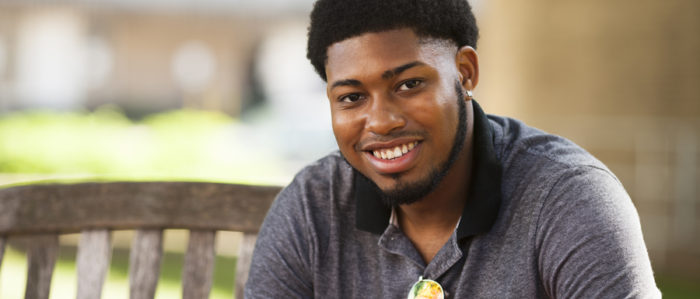When Jeremy Morris launched his podcast class in the spring of 2014, “podcast” wasn’t even in the course title.
“I was worried students weren’t all that interested in them, and they weren’t,” says Morris, an associate professor of media and cultural studies in the Department of Communication Arts.
Then Serial debuted. The true crime podcast, in which a single story is unraveled over a season, was a monster hit from its start in late 2014. While podcasts had been available on iTunes since 2005 — the term “podcast” is actually a mashup of “iPod” and “broadcast” — they had been largely unpolished, niche and dwindling in popularity in recent years. But Serial and other new podcasts turned the tide, to the point that last year, Nielsen reported a full 40 percent of the U.S. population — or 112 million people — had listened to a podcast.
Now, in the midst of what’s often called the “golden age of podcasts,” Morris has doubled enrollment in his 400-level Comm Arts class to include nearly 50 students. Sound Cultures: Podcasting and Music not only exposes students to a variety of podcasts, but also teaches them to think critically about sound and gives them hands-on experience with manipulating audio.
Students’ first assignment is to create a “sound list,” a two- or three-minute playlist of roughly a dozen sounds from daily life. “My day at UW” is the most common theme, starting with the buzz of an alarm clock, while a “Wisconsin winter” playlist might contain the sound of a jacket being zipped up, or boots crunching through snow. The exercise reveals how much can be communicated with just sound.
Morris pulls from the more than 250,000 podcasts available today, from National Public Radio’s This American Life to the design-focused 99% Invisible to audio fiction like Homecoming. He highlights examples including comedy, true crime, political interviews and dramatic fiction, and set-ups ranging from two buddies around a mic to full-fledged professional productions.
“Students come in with assumptions of what a podcast sounds like,” based on the particular types of podcasts they’ve experienced, he says. “The course opens their ears to other shows.”
Each week, the class heads to a lab to learn a new technical skill, such as how to remove background noise, how to loop a beat of music or where to get sounds effects. All the while, Morris emphasizes that there’s much more to a good podcast than technology.
“I like to remind them that the software is going to change,” says Morris, who produced more than 200 episodes of a music podcast while he was in graduate school in Montreal. “It’s more about understanding the role sound can play.”
While some students will go on to work on podcasts, it’s more important to Morris that all gain an awareness of the medium’s place in history.
“Every few years it’s the next big thing, but it’s really been steadily growing and changing,” he says. “Web audio dates back to the early ’90s.”
In fact, the fundamental concept — of conversing, entertaining or sharing news through audio — has been popular since the 1930s. The class spends time teasing out the differences between broadcast radio and podcasts, which anyone can produce and make public fairly easily and inexpensively. But students are often surprised when Morris suggests they may share trajectories.
I like to remind them that the software is going to change. It’s more about understanding the role sound can play.
“Most mass media start out as open, then become consolidated,” he says, adding that established media have found success in podcasts and podcasting networks have recently emerged. This professionalizing is leading to strong, high-quality podcasts, but also a narrowing of what’s being produced.
“I wonder what that means for independent podcasters,” says Morris, who recently received a National Endowment for the Humanities grant to make podcasts easier for scholars and the public to research. “Getting heard is always tricky. Getting into the iTunes store is not enough.”
For the final project of the class, Morris asks student to create a pilot episode of a new podcast. They have come up with some great ideas over the years, Morris says, such as podcasts probing conspiracy theories, reviewing local restaurants, sharing fictional stories and discussing sports. One featured a group of friends playing through a board game, while another was a feminist exploration of menstruation.
Morris hopes students leave the class knowing how to manipulate and sounds through digital audio tools, but more so to think more critically about the role sound plays in constructing their everyday lives, and the ways sound is linked to issues of age, race, class, gender, history and culture.
“I want students to think about why they hear what they hear,” he says. “Sounds aren’t as universal as we think they are.







